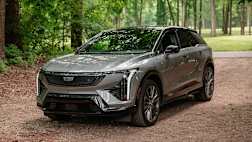AEB is a system that makes your car a better, safer driver than you, basically, which is why it’s a shame it’s not standard fitment on every new vehicle sold.
Once upon a time, some clever engineers invented the Anti-lock Braking System (ABS), and the world was pretty damn impressed with them, because they saved a lot of lives, and even more panel damage, with a system that allowed you to hit the brakes as hard as you humanly liked without them locking up and sending you into a skid.
ABS was the go-to acronym for car safety, and eventually became compulsory on every new car sold (it’s since been joined by ESP - Electronic Stability Program - in the clever/useful/life-saving stakes).
The problem with ABS, of course, was that it still required you, the slightly dopey and occasionally idiotic human, to hit the brake pedal so that the computers could do their clever work in bringing you to a halt.
Now, finally, car companies have improved on that system by creating AEB.
What does AEB stand for? Autonomous Emergency Braking, Automatic Emergency Braking or, simply, Auto Emergency Braking. There are also several brand terms like 'brake support' or 'brake assist' to add to the confusion.
The system is small work of genius that notices when you’re not doing your job with the stop pedal quickly enough, and does it for you. Not only that, but it does it so well that it will, on some cars, prevent you from having any rear-end accidents, ever, at speeds of up to 60km/h.
You can almost hear the insurance companies singing ‘Hallelujah’ (because rear-enders are the most common, at around 80 per cent of all collisions, and thus the most expensive, accidents on our roads). Indeed, some of them are now offering discounts on insurance for cars that have AEB fitted.
How does Autonomous Emegency Braking work and which cars have AEB?
Many modern cars have been equipped with various forms of radar for many years now, and mostly they've been used for things like Active Cruise Control. By constantly measuring the distance between you and the car in front - using radar, or lasers, or both - they can adjust the speed of your car so you don’t need to be constantly switching cruise control on and off.
AEB, which was introduced in 2009 by Volvo, unsurprisingly, works by using those radar systems to measure the distance to any vehicle in front of you, and then react if that distance suddenly starts getting smaller at a great rate of knots - usually because the object in front of you has come to, or is coming to, a sudden stop.
Different car companies use different methods, of course, like Subaru, which bundles AEB into its EyeSight system, which uses cameras instead to create three-dimensional pictures of the world around your car.
Being computer controlled, these systems can react faster than you, so before you’ve even soaked up your typical human reaction time of one second, they are applying the brakes. And doing so, thanks to good old ABS technology, with maximum force.
The car’s CPU watches whether you have gotten off the throttle and are applying the brakes yourself, of course, so it doesn’t always step in before you do, but if you’re not quick enough to stop an accident, it will.
There are a few companies that offer AEB as standard on their entry level cars.
In some situations, particularly in city driving, this can be a bit annoying, when the car panics unnecessarily, but it’s worth putting up with, because you never know when it might be very useful indeed.
Early systems were only promising to save your bacon at speeds of up to 30km/h, but improvements in the technology have been rapid and speeds of 60km/h are now quite a common claim.
So, if it’s so good, it must be standard on all cars?
Well, you might think so, and there is a push from people like ANCAP for it to be made standard on all vehicles - as ABS, ESP and traction control now are in Australia - but it’s far from being the case yet, which is hard to justify.
A few years ago, Volkswagen launched its tiny city car, the Up, with AEB as standard at a starting price of $13,990, which shows it can’t be that expensive. This makes it particularly mysterious that AEB is not standard on all Volkswagens. While you can get it for free on the small SUV Tiguan, it’s an option you have to pay for on other models.
There are a few companies that offer AEB as standard on their entry level cars - the Mazda3 and CX-5 and Skoda’s Octavia - but with most brands you’ll need to buy the up-spec models to have it fitted to your vehicle.
And, of course, you do want it. Car companies know that and can use it as a tempter to walk you up through the range to a more expensive option.
It seems the only thing that will change the situation is legislation, although it’s a handy marketing tool for those, like Mazda, who do decide to make it standard equipment, as it should be.







.jpg)



.jpg)
.jpg)


